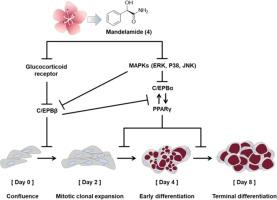Bioorganic & Medicinal Chemistry Letters ( IF 2.5 ) Pub Date : 2021-08-14 , DOI: 10.1016/j.bmcl.2021.128326 Dahae Lee 1 , Ji-Young Kim 2 , Yutong Qi 2 , Sangsu Park 3 , Hye Lim Lee 4 , Noriko Yamabe 1 , Hocheol Kim 5 , Dae Sik Jang 2 , Ki Sung Kang 1

|
Flowers of Prunus persica (L.) Batsch (Rosaceae), known as peach blossoms, have been reported to exert anti-obesity effects by improving hepatic lipid metabolism in obese mice. However, little is known regarding the anti-adipogenic effects of the phenolic compounds isolated from P. persica flowers. This study investigated the inhibitory effects of compounds extracted from P. persica flowers (PPF) on adipogenesis in 3T3-L1 murine preadipocytes using adipogenic differentiation assays. Additionally, we compared the anti-adipogenic effects of the phenolic compounds isolated from PPF, such as prunasin amide (1), amygdalin amide (2), prunasin acid (3), mandelamide (4), methyl caffeate (5), ferulic acid (6), chlorogenic acid (7), benzyl α–L-xylpyranosyl-(1→6)-β-D-glucopyranoside (8), prunin (9), naringenin (10), nicotiflorin (11), astragalin (12), afzelin (13), and uridine (14), on adipogenesis in 3T3-L1 murine preadipocytes. PPF and compounds 4–7 and 10 significantly inhibited adipogenesis. Among them, mandelamide (4) exhibited the maximum inhibitory activity with an IC50 of 36.04 ± 1.82 μM. Additionally, mandelamide downregulated the expression of key adipogenic markers, such as extracellular signal-regulated kinase, c-Jun-N-terminal kinase, P38, CCAAT/enhancer-binding protein α, CCAAT/enhancer-binding protein β, peroxisome proliferator activated receptor γ, and glucocorticoid receptor. These results indicate that mandelamide is an active ingredient of PPF possessing anti-obesity properties.
中文翻译:

Prunus persica (L.) Batsch 花中的植物化学物质:Mandelamide 对 3T3-L1 前脂肪细胞的抗脂肪生成作用
Prunus persica (L.) Batsch (Rosaceae) 的花,被称为桃花,据报道通过改善肥胖小鼠的肝脏脂质代谢发挥抗肥胖作用。然而,关于从桃花中分离的酚类化合物的抗脂肪生成作用知之甚少。本研究使用脂肪分化试验研究了从桃花 (PPF) 中提取的化合物对 3T3-L1 鼠前脂肪细胞脂肪生成的抑制作用。此外,我们还比较了从 PPF 中分离出的酚类化合物的抗脂肪生成作用,例如 prunasin amide ( 1 )、amygdalin amide ( 2 )、prunasin acid ( 3 )、mandelamide ( 4 )、咖啡酸甲酯 ( 5 )、阿魏酸(6 ), 绿原酸 ( 7 ), 苄基 α–L-xylpyranosyl-(1→6)-β-D-吡喃葡萄糖苷 ( 8 ), prunin ( 9 ), 柚皮素 ( 10 ), nicotiflorin ( 11 ), 黄芪甲苷 ( 12 ) 、afzelin ( 13 ) 和尿苷 ( 14 ),关于 3T3-L1 鼠前脂肪细胞的脂肪生成。PPF和化合物4 - 7和10个显著抑制脂肪生成。其中,mandelamide ( 4 ) 表现出最大的抑制活性,IC 5036.04 ± 1.82 μM。此外,mandelamide 下调关键脂肪生成标志物的表达,如细胞外信号调节激酶、c-Jun-N-末端激酶、P38、CCAAT/增强子结合蛋白 α、CCAAT/增强子结合蛋白 β、过氧化物酶体增殖物激活受体γ 和糖皮质激素受体。这些结果表明,扁桃酸是 PPF 的一种活性成分,具有抗肥胖特性。











































 京公网安备 11010802027423号
京公网安备 11010802027423号